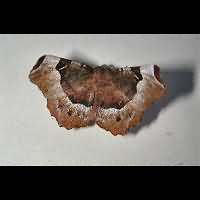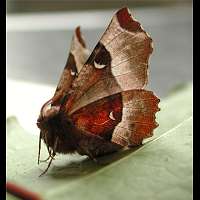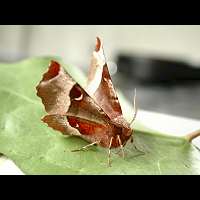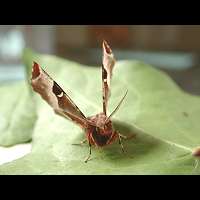Purple Thorn (Selenia tetralunaria)
The Purple Thorn is closely related to the Early Thorn and similar. Identification usually is made easy by the white spot in both wings. This looks like a half moon, and thus the moth is called the Half Moon Moth in Dutch. This spot is visible on both sides of each wing, but best seen on the underside. The Purple Thorn normally keeps it wings half raised and slightly curled. The Early Thorn usually keeps it wings fully raised. There is a big difference between animals of the spring generation and those of the summer generation. The spring genaration consists of big animals (wingspan 46 to 52 mm), richly marked and with white patches and lines. Animals of the summer generation are smaller (wingspan 44 to 46 mm), browner, less marked and lack all traces of white, except for the half moon spot. The animal in the picture at the top belongs to the summer generation, all others belong to the spring generation. In northern parts of Europe, where the animal is single brooded, the moths tend to be even more richly marked and coloured.
The caterpillar of the Purple Thorn is greyish or reddish brown and looks like a twig. It has some bumps that do look like buds: two near the front and just after the middle of the body another two. The third pair of legs is swollen, also making a bud like impression. It feeds by day and sits almost motionless during the day. In this way it is so well camouflaged, that it is hardly ever found on the host plants. It may reach a length of almost 4 cm. In October is spins together a few leaves in which it pupates. Leaves and pupa drop to the floor in autumn and the pupa overwinters. Sometimes the larvae falls out of the tree and pupates and overwinters under mosses. The caterpillar can be found on many trees, including oak, birch, alder, hazel and blackthorn.
In Northern Britain the Purple Thorn is single brooded, on the wing from June to August. In Southern Britain is is double brooded, on the wing from April to September. In warmer parts of Europe and occasionally in Southern England a small third generation may be on the wing in September and August. Even though it is not seen very often this is a very common species in most of Europe, but its area doesn't cover northern parts. It is rare or even absent in most of Scotland and Scandinavia, areas where the similar Early Thorn usually is quite common. The moth is not seen frequently. It is well hidden during the day, flies after darkness and comes to light in small numbers only.
The Purple Thorn is closely related to the Early Thorn and similar. Identification usually is made easy by the white spot in both wings. This looks like a half moon, and thus the moth is called the Half Moon Moth in Dutch. This spot is visible on both sides of each wing, but best seen on the underside. The Purple Thorn normally keeps it wings half raised and slightly curled. The Early Thorn usually keeps it wings fully raised. There is a big difference between animals of the spring generation and those of the summer generation. The spring genaration consists of big animals (wingspan 46 to 52 mm), richly marked and with white patches and lines. Animals of the summer generation are smaller (wingspan 44 to 46 mm), browner, less marked and lack all traces of white, except for the half moon spot. The animal in the picture at the top belongs to the summer generation, all others belong to the spring generation. In northern parts of Europe, where the animal is single brooded, the moths tend to be even more richly marked and coloured.
The caterpillar of the Purple Thorn is greyish or reddish brown and looks like a twig. It has some bumps that do look like buds: two near the front and just after the middle of the body another two. The third pair of legs is swollen, also making a bud like impression. It feeds by day and sits almost motionless during the day. In this way it is so well camouflaged, that it is hardly ever found on the host plants. It may reach a length of almost 4 cm. In October is spins together a few leaves in which it pupates. Leaves and pupa drop to the floor in autumn and the pupa overwinters. Sometimes the larvae falls out of the tree and pupates and overwinters under mosses. The caterpillar can be found on many trees, including oak, birch, alder, hazel and blackthorn.
In Northern Britain the Purple Thorn is single brooded, on the wing from June to August. In Southern Britain is is double brooded, on the wing from April to September. In warmer parts of Europe and occasionally in Southern England a small third generation may be on the wing in September and August. Even though it is not seen very often this is a very common species in most of Europe, but its area doesn't cover northern parts. It is rare or even absent in most of Scotland and Scandinavia, areas where the similar Early Thorn usually is quite common. The moth is not seen frequently. It is well hidden during the day, flies after darkness and comes to light in small numbers only.










